Winter can be a tough time for our feathered friends, especially those that brave the chilly months in colder climates. While we cozy up indoors, many birds face a daily battle against plummeting temperatures and dwindling food supplies.
But here’s the good news: you can be a hero to these resilient creatures with just a few simple actions. With millions of birds struggling to survive each winter, your efforts can genuinely make a world of difference.
Imagine waking up to a winter wonderland, the ground sparkling with snow and the trees cloaked in white. While the scene is magical for us, it’s a challenging landscape for birds. They face freezing winds, long nights, and the constant search for nourishment and shelter.
It might surprise you, but with a little planning and a big heart, you can play a crucial role in ensuring that birds not only survive but thrive during these harsh months.
So, why not roll up your sleeves and start making a difference today? Below are three tried-and-true strategies to support our avian neighbors throughout the winter.
By embracing these practices, you’ll be doing far more than feeding the birds; you’ll be creating a sanctuary right in your backyard.
1. Leave Ornamental Grasses Standing: Nature’s Winter Shield and Buffet

Believe it or not, having a wild side to your garden can be life-saving for birds. You might feel the urge to tidy up your ornamental grasses as the leaves fall, but resist the call of the rake! These towering plants become natural shelters that protect birds from wind, cold, and lurking predators.
The Power of Nature’s Buffer
Ornamental grasses like switchgrass and maiden grass act as vital windbreaks. Imagine being a small bird caught in an icy gale; these grasses provide a cozy haven, helping conserve precious energy. Their tall, resilient stems stand guard even under heavy snow, offering much-needed respite.
A Perfect Blend of Beauty and Function
Beyond their protective qualities, these grasses also add a touch of elegance to the winter landscape. Their graceful arcs dusted with snow create a picturesque scene that’s both functional and beautiful. Additionally, these plants offer birds a place to hide from predators like hawks and cats, keeping them safe and sound.
Seeds: The Unexpected Feast
Don’t forget about the seeds! The seed heads of grasses are a vital food source for seed-loving birds such as sparrows and finches. By leaving your grasses untouched, you’re providing both shelter and sustenance—a perfect all-in-one package for our winged friends.
2. Consistent High-Energy Feeding: Power Up Their Diet

Birds burn more calories during winter just to stay warm, much like how we crave hot cocoa and hearty soups. Offer them a consistent supply of high-energy foods to keep them fueled and ready to face the cold.
Top Picks for Winter Feeding
Black Oil Sunflower Seeds: These tiny powerhouses are packed with fat and protein, making them a favorite among many bird species. Their thin shells are easy to crack, even for smaller birds.
Suet Cakes: Think of suet as the bird version of a protein bar. It’s especially beneficial for insect-eating birds like woodpeckers and nuthatches. You can either buy them ready-made or mix up some beef fat with seeds and nuts for a homemade treat.
Peanuts and More: Unshelled peanuts provide both fat and protein, while Nyjer seeds attract beautiful finches. Mealworms round out the menu, offering an excellent protein boost, especially appreciated by bluebirds and robins on particularly frosty days.
The Importance of Routine
Once birds discover your feeders, they might rely on them, especially when natural food sources are buried under snow. It’s essential to keep those feeders stocked, ensuring that the feathered visitors aren’t caught off guard when hunger strikes.
3. Provide Fresh Water: The Forgotten Necessity

While it might seem like birds can hop over to a snowbank for a drink, melting snow consumes more energy than they can afford to use in freezing weather. It’s vital to provide them with fresh, unfrozen water.
Keeping Water Accessible
Consider installing a heated bird bath or adding a bird bath heater to prevent the water from freezing over. These devices ensure that birds can drink and bathe without expending extra energy.
The Importance of Bathing
Clean feathers mean better insulation, which helps birds stay warm. Regularly bathing in open water allows birds to maintain the condition of their plumage, keeping them snug through those long winter nights.
Things to Consider
Choose a bird bath with a non-slip surface to prevent accidents. Keeping it clean is equally essential to avoid algae and bacteria buildup, which could harm the birds.
By implementing these strategies, you transform your garden into a winter sanctuary for birds. Not only will you help them survive the tougher months, but you’ll also enjoy a lively and vibrant backyard, full of chirps, flutters, and the joy of knowing you made a difference. So, here’s to spreading warmth this winter—both in your heart and in your garden!

